 |
 |
 |
| |
GSK364735 is a Potent Inhibitor of HIV Integrase and Viral Replication
|
| |
| |
Reported by Jules Levin
ICAAC Sept 17-20, 2007, Chicago
Edward Garvey1, Brian Johns1, Scott Foster1, Wayne Miller1, Robert Ferris1, Richard Hazen1, Mark Underwood1, Eric Boros1, James Thompson1, Jason Weatherhead1, Cecilia Koble1, Scott Allen1, Lee Schaller1, Ron Sherrill1, Tomokazu Yoshinaga2,
Takeshi Noshi2, Masanori Kobayashi2, Akihiko Sato2
1GlaxoSmithKline, 2Shionogi
AUTHOR CONCLUSIONS
GSK364735 is a potent low-nanomolar inhibitor of HIV replication in cellular assays through the mechanism of inhibiting HIV integrase.
GSK364735 inhibits recombinant HIV integrase in vitro.
GSK364735 inhibits after viral DNA synthesis and during viral DNA integration.
GSK364735 is sensitive to integrase acitve-site mutations.
GSK364735 itself selects for integrase active-site mutations.
GSK364735 blocks HIV replication in a clade- and clinical isolate-independent fashion.
GSK364735 is equi-potent against wild-type virus and all clinically relevant mutant viruses resistant to currently marketed anti-retrovirals.
GSK364735 shows no antagonism with any marketed anti-retroviral and shows potential for synergy in in vitro cellular combination studies.
Note: GSK364735 was successfully evaluated in two Phase I healthy subject studies and in a Phase II study in HIV-infected patients; however, adverse liver effects of GSK364735 were recently observed in a long-term preclinical safety study in the monkey and preclude further development of the compound. (In speaking with GSK officials there are additional backup integrase compounds for development).
BACKGROUND
After many years of pharmaceutical research, HIV integrase has evolved into a highly tractable target (1) with several examples of potent inhibitors entering clinical trials in the last five years (2). The Shionogi-GSK Joint Venture previously tested S1360 in Phase IIa studies and discovered and took RSC-1838 into pre-clinical development. The continuing collaboration has now lead to the novel integrase inhibitor (INI) GSK364735 (see also accompanying poster H-1047). This poster describes GSK364735's potency and mechanism of inhibition of HIV integrase and viral replication. The structure of GSK364735 is shown below. It belongs to the two-metal binding scaffold naphthyridinone, or NTD. The NTD scaffold will be thoroughly described in future publications.
METHODS
In vitro recombinant HIV integrase activity was measured in a strand transfer scintillation proximity assay (SPA), with purified integrase first complexed with a biotinylated viral DNA oligonucleotide duplex prior to addition of inhibitor (4). A separate SPA was utilized for mechanism studies where [3H]GSK304649 was added to the binary biotinylated viral DNA oligonucleotide/integrase complex. GSK304649 is another NTD and its structure is shown below. In separate experiments, this ligand was displaced by a wide variety of two-metal binding INIs with expected potencies.
Several cellular antiviral assays measuring viral replication were employed. A two-day PHIV assay used a pseudo-type virus infecting 293T cells which resulted in expression of LTR-driven luciferase. A four-day MT4 assay measured the cytopathic effect of IIIB HIV-1 on MT4 cells. A five-day PBMC assay used Ba-L HIV-1 and PHA/IL-2 stimulated human PBMC cells, and quantitated virus in the cell supernatant via reverse transcriptase measurement. Molecular clones of viruses resistant to marketed HIV drugs were tested in either the MT4 cell system or a system utilizing HeLa-CD4 cells. Cytotoxicity was measured in the indicated cell types measuring ATP levels with a luciferase-based detection. Mechanistic studies examining the effect of compound on viral DNA production and integration were done with NL432 virus and MT4 cells. Generation of virus resistant to inhibitor was done by passage of IIIB virus in MT2 cells in the presence of increasing concentrations of GSK364735 for up to 84 days. Finally, testing of GSK364735 against various HIV clades and HIV-1 clinical isolates was done at Southern Research Institute and at Monogram, respectively.
For comparison sake, the potencies of INIs that have shown pronounced clinical efficacy in Phase II studies (L-870,810, MK-0518, and GS-9137) were also measured in the above assays. All compounds were synthesized either at GSK or Shionogi.
RESULTS and DISCUSSION
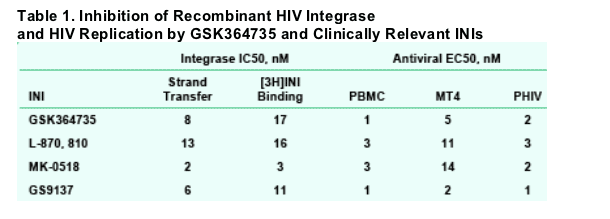
GSK364735 inhibited recombinant HIV integrase in a strand transfer assay with nanomolar potency, and displaced a radiolabelled INI with potency consistent with competitive binding at the 2-metal binding inhibitor site. Likewise, its antiviral potency in three different cellular assays was low nanomolar and very similar to potencies of the three INIs that have shown clinical efficacy (L-870,810, MK-0518 and GS9137). Finally, GSK364735 was tested for cytotoxic effects in IM-9, MOLT-4, MT4, U937, and PBMCs (stimulated and non-stimulated), with CCIC50 values of 2, 11, 44, >100, 55, and >100 _M, respectively.
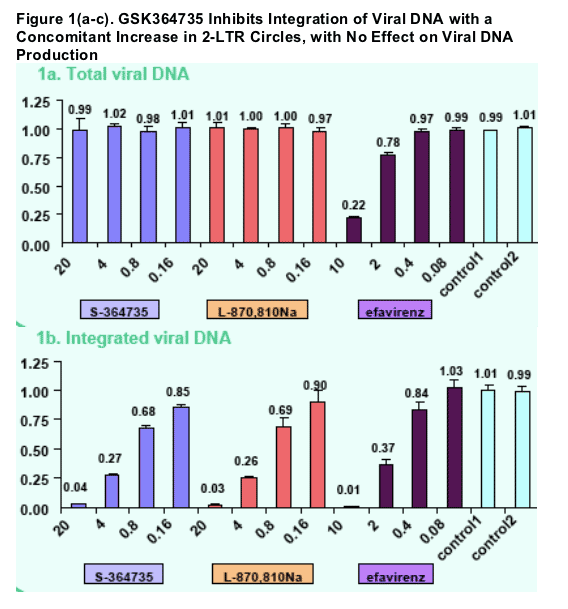
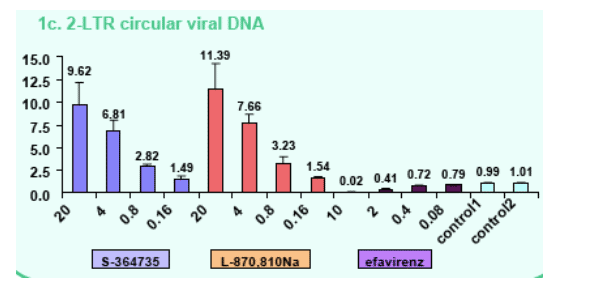
Inhibition of Different HIV Clades and Clinical Isolates by GSK364735
GSK364735 was tested against a panel of clinical HIV-1 subtype isolates and HIV-2 isolates in PBMCs (Table 2). Twenty-five virus isolates were evaluated, which included three individual isolates from each of the HIV-1 group M subtypes [A, B, C, D, E, F and G], as well as the lab-adapted group M subtype B isolate HIV-1 Ba-L and three HIV-1 group O isolates. In addition, four HIV-1 isolates (three of which were also evaluated in PBMCs) were evaluated in monocyte-derived macrophages (MDM) and three HIV-2 isolates were also evaluated in PBMCs. GSK364735 was determined to be highly active with broad activity against a total of 26 unique HIV-1 isolates and three HIV-2 isolates. GSK364735 was also active against HIV-1 containing the integrase coding region from 13 clade B clinical isolates and two control lab strains (HIV-1 IIIB and HXB2) in an isogenic background.

Inhibition of resistant HIV strains by GSK364735.
GSK364735 retained full potency against HIV strains resistant to marketed drugs. GSK364735 showed efficacy against five different RTI-resistant viruses with activity equivalent to that against wild type virus (IC50's = 2.2 to 3.7 nM). Likewise, GSK364735 showed efficacy against four different PRI-resistant viruses with activity equivalent to that against wild type virus (IC50's = 2.0 to 3.2 nM).
GSK364735 demonstrated anti-HIV activity equivalent to wild type virus against seven INI mutant viruses (T66I, E92Q, T124A, P145S, Q146R, S153Y, and M154I) and reduced activity against nine mutant viruses (T66K, F121Y, Q148K, Q148R, N155S, T66I/E92Q, T66K/L74M, E138K/Q148R and G140S/Q148K). These data further support that GSK364735's mode of action is through inhibiting integrase and that it binds in the same pocket at or near the active site as do other potent two-metal binding INIs.
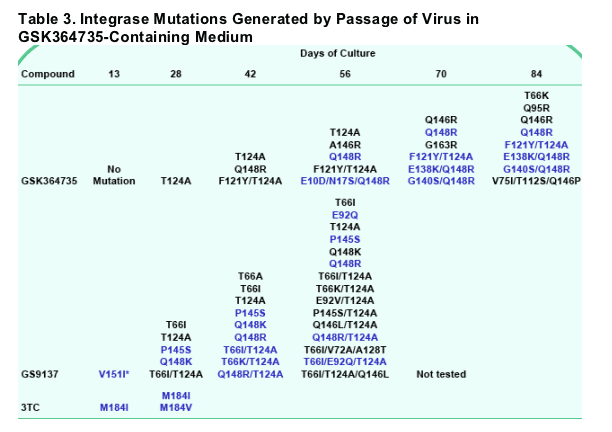
Blue indicates mutations caused a >10-fold decrease in potency relative to potency against wild-type virus.
HIV was passaged in medium containing increasing concentrations of GSK364735, GS9137 (another INI in clinical development), or 3TC (as a control for rapid resistance). Rapid resistance within pronounced phenotypic impact was confirmed with the M184I mutation arising by day 13 of passage in 3TCcontaining medium. Mutations within the integrase-coding region were selected by both GSK364735 and GS9137 consistent with both molecules targeting inhibition of integrase as their antiviral mechanism.

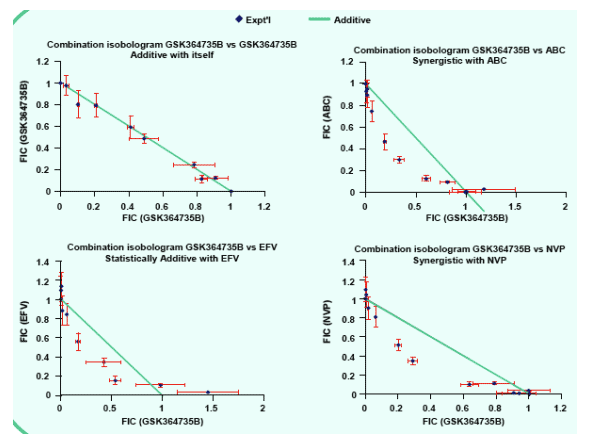
GSK364735 was studied in combination with 17 marketed drugs used to treat HIV infection primarily to confirm that there was no antagonistic potential. No antagonism was observed in any study. In seven of the 17 studies, the combination was statistically defined as synergistic, with the remaining 10 studies being defined as additive. The clinical relevance of these combination studies remains to be determined.
References
1. Pommier, Y, Johnson, AA, Marchand, C. (2005) "Integrase inhibitors to treat HIV/AIDS." Nat Rev Drug Discov 4(3): 236-248.
2. O'Neil, R. (2006) "MK-0518 and GS-9137: two promising integrase inhibitors in the pipeline." Bull Exp Treat for AIDS (BETA) 18(4):13-6.
3. Boros, EE, Johns, BA, Garvey, EP, Koble, CS, Miller, WH. (2006) "Synthesis and HIV-integrase strand transfer inhibition activity of 7-hydroxy[1,3]thiazolo[5,4-b]pyridin-5(4H)-ones." Bioorg Med Chem Lett 16(21): 5668-5672.
|
| |
|
 |
 |
|
|